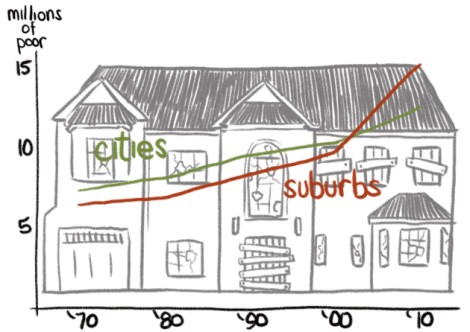At one time, escaping the dirty, dangerous city was a privilege. Now the wealthy are flocking back for newly “livable,” walkable neighborhoods that are safer than they’ve been in decades. New residents are remaking cities in their own image, driving prices way up, and ultimately pushing poorer city dwellers out to the suburbs.
A new report from the Brookings Institution, “Confronting Suburban Poverty in America,” reveals how formerly affluent bedroom communities have faltered in recent years. Brookings researchers found that between 2000 and 2011, the rate of poverty in the American suburbs grew by nearly two-thirds — more than twice as fast as it did in cities. “The federal government spends $82 billion a year across more than 80 programs to address poverty in place,” the study notes. “But the spread-out nature of suburban poverty, and the lack of expert public and nonprofit service providers in suburbs, mean that most of those dollars remain focused on urban communities.”
Here’s a chart showing the increase in suburban vs. urban poverty in the last few decades:

To some degree, it makes sense that there are more poor people in the suburbs than there are in cities: Three times as many people live in the suburbs as in urban centers in the U.S. What’s really notable here is the rate of change.
But this report doesn’t really say that cities are winning. If anything, it says we’re all losing — you’ll notice that both of those trend lines in the graph are on the rise. It’s further evidence of the growing wealth chasm and how it dictates our choices.
Suburban poverty isn’t the epidemic — poverty is. Regardless, Brookings seems to have offended suburban champions who argue that white-picket-fence, car-friendly living is the real American way of life.
There are a few reasons the suburbs are losing wealth way faster than cities, besides the fact that comfy car-free city-living has become such an attractive, increasingly elite lifestyle. Working- and service-class industries moved to the suburbs, then crashed, while more lucrative “creative class” industry jobs have largely concentrated in urban centers. Cities are not only attracting the wealthy, but rewarding them for their investments. Urban home values have maintained and even increased while suburban ones have crashed on people for whom their house was their greatest asset and investment.
And living in the suburbs often requires extra resources. Hundreds of thousands of poor suburban families don’t have cars, so daily life becomes a time-consuming struggle of simply getting around places that have limited public transportation and often no bike-friendly infrastructure to speak of.
None of this sits well with those who champion the ‘burbs. Suburb-lovers and Richard-Florida-haters Joel Kotkin and Wendell Cox have some choice words for urbanists at the Daily Beast. They call Brookings “something of a Vatican for anti-suburban theology,” pointing out great wealth disparities in large cities such as Chicago and New York, and championing suburban growth.
But suburban poverty is real. It’s the other side of the urban-gentrification coin toss — the losing side. When a city neighborhood hits peak coffee shop and beer garden, when families move out and investors move in, locals get pushed out. And the organizers and activists and the resources fighting for the poor don’t always follow them to the suburbs to keep helping out.
The major concern here is not just that poor people are being pushed out of the cities they’ve called home. It’s that when they’re in the suburbs, those poor people have a lot fewer opportunities to thrive.
Brookings has been beating this poor-suburbs drum for years now. “This ongoing shift in the geography of American poverty increasingly requires regional scale collaboration by policymakers and social service providers in order to effectively address the needs of a poor population that is increasingly suburban,” a 2010 Brookings report read.
Ironically, despite all the sniping back and forth between city lovers and suburban apologists, this is one point on which everyone seems to agree: “Rather than castigating suburbs for exaggerated dysfunction, retro-urbanists would be much better served focusing on how to correct and confront the issue of poverty, which continues to concentrate heavily in the urban core and elsewhere in America,” Kotkin and Cox conclude.
Such a vital issue shouldn’t — and doesn’t, really! — pit urbanists against suburbanists. No city is an island. Urban living is great, but ultimately our cities are only as great as the poverty concentrated in their centers, now spilling out into their suburbs.



